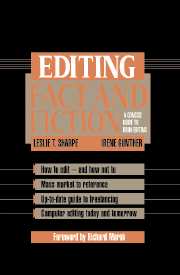Book contents
- Frontmatter
- Contents
- Foreword
- Acknowledgments
- Introduction
- Chapter 1 Who (and What) Is an Editor?
- Chapter 2 Fact or Fiction? Finding Your Niche
- Chapter 3 Principles to Edit By
- Chapter 4 The Editor's Senses
- Chapter 5 The Editor's Sensibility
- Chapter 6 A Guide to Editorial Freelancing
- Chapter 7 Electronic Editing Today and Tomorrow
- Chapter 8 Tools of the Trade and How to Use Them
- Index
Chapter 8 - Tools of the Trade and How to Use Them
Published online by Cambridge University Press: 21 September 2009
- Frontmatter
- Contents
- Foreword
- Acknowledgments
- Introduction
- Chapter 1 Who (and What) Is an Editor?
- Chapter 2 Fact or Fiction? Finding Your Niche
- Chapter 3 Principles to Edit By
- Chapter 4 The Editor's Senses
- Chapter 5 The Editor's Sensibility
- Chapter 6 A Guide to Editorial Freelancing
- Chapter 7 Electronic Editing Today and Tomorrow
- Chapter 8 Tools of the Trade and How to Use Them
- Index
Summary
At the Editor's Elbow
If you're a beginning editor, in particular a freelancer with limited resources, chances are you'll have on your desk only the basic editing tools–a couple of lined pads, a few wellsharpened colored pencils with erasers, removable self-stick notes or other flags in different sizes. And, of course, a dictionary and a style manual.
As an in-house staff editor you may also have access to an in-house library with a good selection of reference books; as a freelancer, you'll find a valuable resource in your local public library. But before taking a step away from your desk, know your dictionary and style manual and familiarize yourself with their contents. You'll probably be surprised to find out how much information you have right at your fingertips–and how much time you can save by being aware of it.
You will, of course, use your dictionary to check the meanings of words, their spellings and correct division into syllables, and sometimes to look for synonyms. But you should also be aware of the considerable reference information most college dictionaries now contain.
- Type
- Chapter
- Information
- Editing Fact and FictionA Concise Guide to Book Editing, pp. 196 - 222Publisher: Cambridge University PressPrint publication year: 1994

